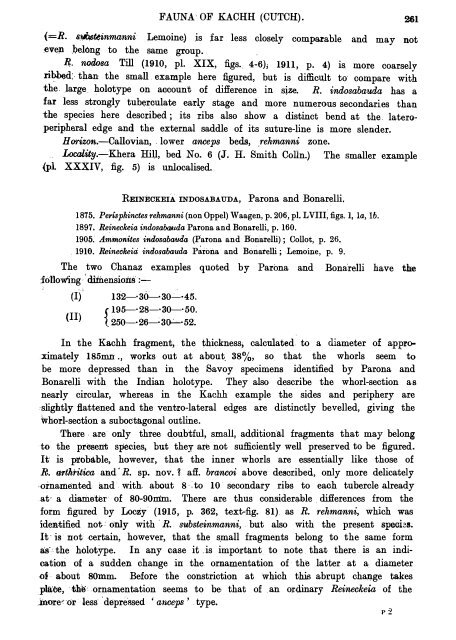ialontolngia ndita,
ialontolngia ndita,
ialontolngia ndita,
Create successful ePaper yourself
Turn your PDF publications into a flip-book with our unique Google optimized e-Paper software.
FAUNA OF KACHH (CUTCH).<br />
261<br />
(=R. s,inmanni Lemoine) is :far less closely comparable and may not<br />
:eve;n ,belong to the same group . .<br />
.<br />
R,. nodosa Till (1910, pl. XIX, figs. 4-6), 1911, p. 4) is. more coarsely<br />
n})bed:- than the small . example here figured, but is difficult to compare with<br />
the . large holotype on account of difference in size. R. indosabauda has a<br />
far less strongly tuberculate early stage and more numerous secondaries than<br />
the species here described ; its ribs also show a distinct bend at the lateroperipheral<br />
edge and the external saddle of its suture-line is more slender.<br />
H orizon.-Callovian, . lower anceps beds, rehmanni zone.<br />
Locality.-Khera Hill, bed No. 6 (J. H. Smith Colln.) The smaller example<br />
(pl. XXXIV, fig. 5} is unlocalised.<br />
REINECKEIA INDOSABAUDA, Parona and Bonarelli.<br />
1875. Perisphinctes rehmanni (non Oppel) Waagen, p. 206, pl. LVIII, figs. I, la, lb.<br />
1897. Reineckeia indosalxwda Parona and Bonarelli, p. 160.<br />
1905. Ammonites indosabauda (Parona and Boriarelli) ; Collot, p. 26 .<br />
. 1910. Reineckeia indosabauda P rori.a and Bonarelli ; Lemoine, p. 9.<br />
The two Chanaz examples quoted by Parona and Bonarelli have the<br />
follow'ing · ' difuension:s· :-<br />
-. i<br />
(I)<br />
(II)<br />
132-·3o-· 3o-·45.<br />
s 195-·28-·30-· 50.<br />
t 25o--26-·3o-:--·52.<br />
In the Kachh fragment, the thickness, calculated . to a diameter of appro<br />
ximately 185mn ., works out at about. 38%, so that the whorls seem to<br />
be more depressed than in the Savoy specimens identified by Parona and<br />
Bonarelli with the Indian holotype. They also describe the whorl-section as<br />
nearly circular, whereas in the Kaehh example the sides and periphery are<br />
:slightly flattened and the ventro-lateral edges<br />
horl-section a suboctagonal outline.<br />
There . are only<br />
are distinctly bevelled, giving the<br />
three doubtful, small, additional fragments that may belong<br />
to the present species, but they are not sufficiently well preserved to be figured.<br />
It· is probable, however, that the inner whorls are essentially like those of<br />
R. arthritica and · R. sp. nov. 1 aff. brancoi above described, only more delicately<br />
ornamented and . with. about 8 ·.to 10 · secondary ribs to each tubercle already<br />
at · a diameter of 80-90m'm. There are thus considerable . differences from the<br />
form figured by Loczy (1915, p. 362, text-fig. 81} as R. rehmanni, which was<br />
identified not : only with · R. substeinmanni, . but also with the pre:;;ent spechs.<br />
It · is not certain, however, that the s.mall fragments belong to the same form<br />
as· the holot}rpe.<br />
In any case it .is important to note that there . is an indication<br />
of a sudden change in the ornamentation of the latter . at a. diameter<br />
.oi about 80mm. Before the constriction at which this abrupt cha,:tge takes<br />
pla, th· ornamentation seems to be, that of . an ordinary Reineckeia of the<br />
.Jnore ·or less· ·depressed ' anceps '<br />
type.<br />
P2
















